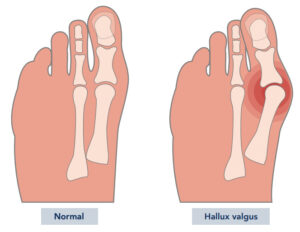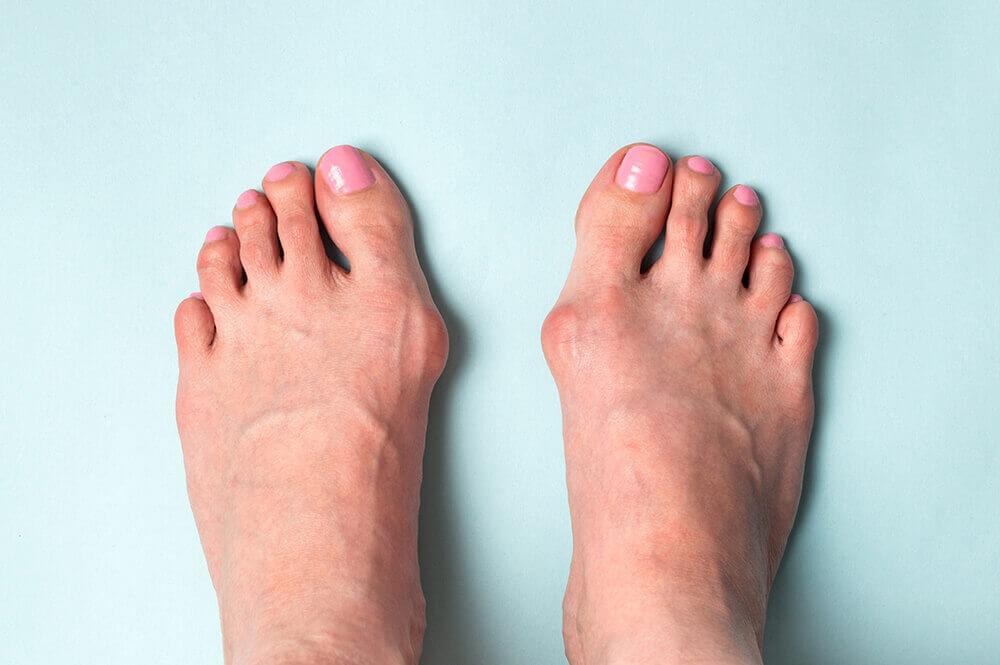Hallux Valgus – per medical definition this is medial deviation of the 1st metatarsal and lateral deviation of the great toe.

I see plenty of clients coming in with this problem, but not for this problem. Usually their complaint is somewhere in the hips, knees, back, or neck. What these clients almost never consider, is that the two are connected. They most certainly are, and that is a discussion for another time.
What is the cause of Hallux Valgus?
Conventional wisdom theorizes that Hallux Valgus is caused by a combination of poor genetics and ill fitting shoes. They are right, in my opinion. Some peoples genetics makes them more susceptible to the dangers of wearing shoes. Shoes support the foot, supporting the foot lessens the requirement for the foot to maintain it’s mechanics – so as the foot weakens from the shoe, the more the foot requires the shoe. Eventually the end-game is an orthotic, which completely interrupts the foots natural ability to pronate and alters the entire kinetic chain. Zipfel and Burger (2007) observed that shod populations exhibit far more deformities of the foot than unshod populations, very much counter to our popular belief for the necessity of shoes (1). For more anthropologic evidence and discussion concerning the history of the human foot & shoes, read this fantastic article.
Is Hallux Valgus & its Associated Ailments Permanent?
Traditional wisdom would say yes – I’m inclined to say no. The bones of the foot have been deformed due to Wolff’s Law – the bone deforms due to the stresses placed on it. Remove those improper stressors, restore normal biomechanics, stress the bones properly and normal function can be restored. Every bone in the adult body remodels at a rate of 10% per year. Reforming it in the right direction would require time, dedication, and stressing the foot in the proper direction in as much the same way as it was ignored and stressed in the wrong direction for many years. I have no proof or studies to cite to support this argument, just basic logic and a lot of exposure to the limited reductionist approach most therapeutic interventions take.

My Approach
To solve a problem in any system, we must have knowledge of that system, the ability to test the pieces of that system, and to make change in the system – this is true of all systems, whether that is a computer, smartphone, biological ecosystem, or the human body.
In the case of the foot, I generally follow a step-by-step process:
- Assess the position of the foot (via AiM)
- Assess movement of the foot & body
- Test function of the muscles of the foot using NKT™
- Analyze my findings, develop a theory
- Restore muscular function using ART® & P-DTR
- Get the foot & body to experience optimal movement (via AiM)
- Repeat Steps 5-6 as time allows
- Reinforce correct foot positioning using Rocktape
- Assign corrective exercise homework for the foot
In addition to this I always have a recommendation for new shoes, and new lifestyle habits. After all, doing the same thing and expecting different results would be the definition of insanity. Don’t settle for pain. Contact me for your initial appointment.
References:
(1) – Zipfel, B., and L. R. Berger. 2007. Shod versus unshod: The emergence of forefoot pathology in modern humans? The Foot 17: 205–213. doi:10.1016/j.foot.2007.06.002
FAQ Section: Hallux Valgus & Bunions in Santa Rosa, CA
1. What exactly is Hallux Valgus and what causes it?
Hallux Valgus, medically defined as the inward deviation of the big toe and outward deviation of the first metatarsal, often results from a combination of genetic predisposition and wearing ill-fitting shoes. The repetitive pressure and lack of proper support from footwear can weaken the foot’s natural mechanics, leading to deformities over time.
2. Are Hallux Valgus and its associated issues permanent conditions?
Contrary to traditional beliefs, Hallux Valgus and its associated ailments are not necessarily permanent. By addressing the underlying biomechanical imbalances and reducing improper stressors on the foot, it’s possible to promote bone remodeling and restore normal function gradually. With dedication to corrective measures and proper foot care, significant improvements can be achieved over time.
3. What approach do you take to address Hallux Valgus and bunions?
My approach to treating Hallux Valgus involves a comprehensive assessment of foot position and movement patterns, utilizing advanced techniques like AiM (Assess, Isolate, and Mobilize), NKT™ (NeuroKinetic Therapy), ART® (Active Release Techniques), and P-DTR (Proprioceptive Deep Tendon Reflex). By restoring muscular function, optimizing movement mechanics, and reinforcing proper foot positioning, I aim to alleviate pain and promote long-term recovery.
4. Can Hallux Valgus be linked to other musculoskeletal issues?
Absolutely. Hallux Valgus often manifests alongside other musculoskeletal complaints, such as hip, knee, back, or neck pain. The interconnectedness of the body means that issues in one area can impact others. Addressing Hallux Valgus comprehensively involves recognizing these connections and implementing strategies to restore overall biomechanical harmony.
5. What role do genetics and footwear play in the development of Hallux Valgus?
Genetics can predispose individuals to structural foot abnormalities, making them more susceptible to conditions like Hallux Valgus. Ill-fitting shoes exacerbate these issues by altering foot mechanics and increasing pressure on vulnerable areas. It’s essential to choose footwear that provides adequate support and allows for natural foot movement to prevent or manage Hallux Valgus effectively.
6. Is there scientific evidence supporting non-surgical approaches to treating Hallux Valgus?
While empirical evidence may be limited, the principles behind non-surgical interventions for Hallux Valgus are rooted in biomechanics and tissue adaptation. By addressing underlying imbalances and promoting proper foot function through targeted therapies and corrective exercises, individuals can experience significant relief from symptoms without resorting to surgery.
7. Can lifestyle modifications contribute to managing Hallux Valgus?
Absolutely. Lifestyle modifications, such as wearing supportive footwear, maintaining a healthy weight, and incorporating regular stretching and strengthening exercises, play a crucial role in managing Hallux Valgus. These adjustments help reduce stress on the foot, promote optimal biomechanics, and support long-term recovery efforts.
8. What steps can individuals take to prevent Hallux Valgus?
Preventing Hallux Valgus involves proactive measures, including wearing properly fitting shoes with adequate arch support, avoiding high heels and narrow-toed footwear, and maintaining a healthy weight to reduce pressure on the feet. Regular foot exercises, such as toe stretches and foot strengthening routines, can also help maintain optimal foot health and prevent deformities.
9. How soon should someone seek treatment for Hallux Valgus symptoms?
It’s essential to address Hallux Valgus symptoms as soon as they arise to prevent further progression and complications. If you experience persistent foot pain, visible deformities, or difficulty wearing shoes, don’t hesitate to consult a healthcare professional specializing in foot health. Early intervention can significantly improve outcomes and minimize the need for invasive treatments.
10. What can individuals expect from treatment for Hallux Valgus?
Treatment for Hallux Valgus focuses on alleviating symptoms, restoring foot function, and preventing further deformity. Depending on the severity of the condition, treatment may involve a combination of manual therapies, corrective exercises, orthotic devices, and lifestyle modifications. With dedication to the prescribed treatment plan and ongoing foot care, individuals can experience improved mobility and quality of life.
